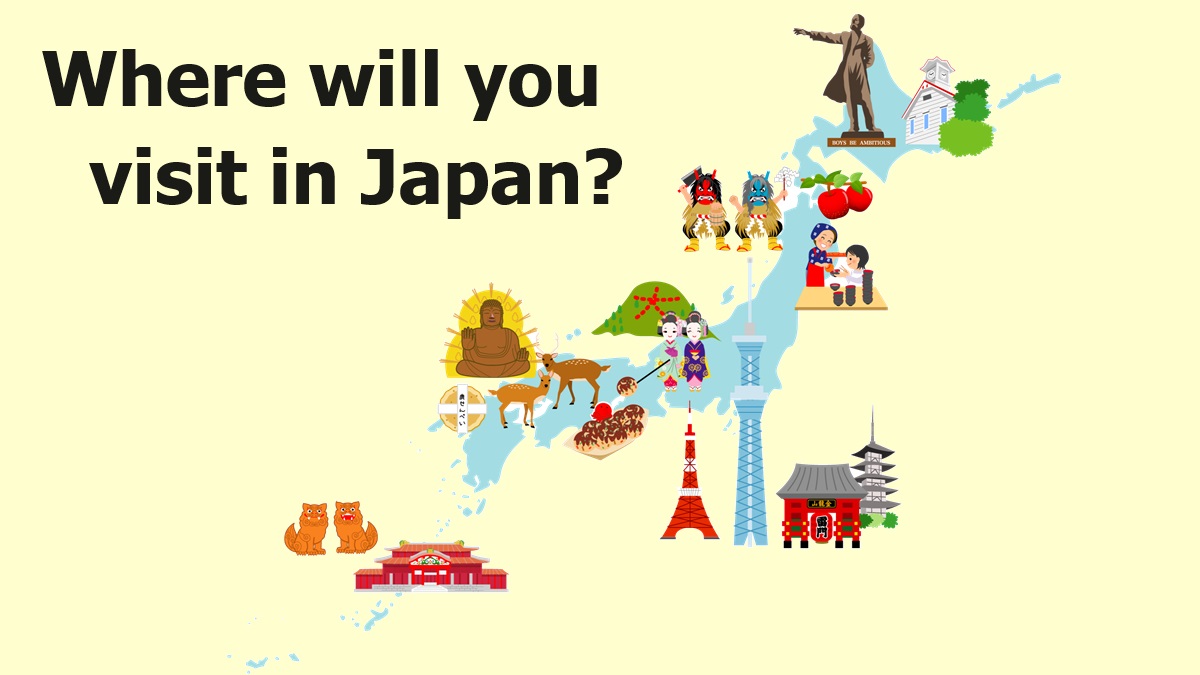Where will you visit in Japan?
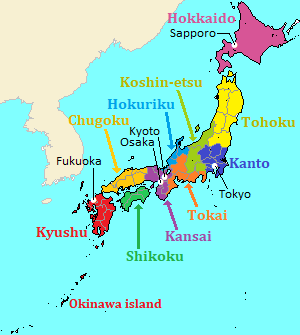
Regions in Japan
Japan is not so large, but the land is narrow and long.
The distance from north to south is over 2,000 km, so you should consider the long distance when you travel around Japan
For example, the distances from Tokyo are about 450 km to Kyoto, Osaka, over 800 km to Hokkaido, Kyushu Islands, and about 1,500 km to Okinawa islands.
In such land, there are 47 prefectures and each has created the unique culture and history.
There is 10 regions and a region consists of a few prefectures.
A region is a wide local area.
Tokyo and Kyoto have been the capitals of Japan over a long period of history.
Most foreign tourists visit there, so both cities are overcrowded with foreign tourists now.
But there are many other interesting cities and towns in Japan.
First, check each region in Japan.
Every year, The New York Times in US introduces "Places to go in the year" in the world.
And, "National Geographic" in US introduces "Best of the World in the year".
Some places in Japan have ever been selected.
Overview of each region
Kanto & Kansai
Northern Japan
Tohoku
Hokkaido
Central Japan
Koshin-etsu
Hokuriku
Tokai
Western Japan
Chugoku
Shikoku
Kyushu & southern islands
Kanto and Kansai
Kanto is the region centering around Tokyo.
Kansai is the region with Kyoto, Osaka.
These are the historical central areas of Japan.
There are the international airports, so these regions are the starting points of travel for most tourists.
Kanto Region
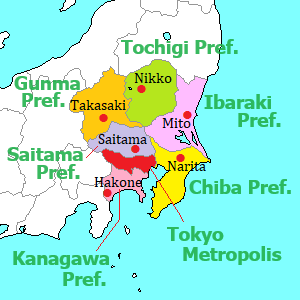
Tokyo (東京) is the capital of Japan with a population of 14 million.
Narita International Airport is located about 50 km east of Tokyo and Haneda International Airport are located in the south part of central Tokyo.
These are the main entrances into Japan.
In the big city, there are both new Tokyo and traditinal Edo (old name of Tokyo).
From the 17th century, this city had developed by samurai and vigorous townsmen.
To the south of Tokyo, there are Yokohama (横浜) city and an ancient city Kamakura (鎌倉) which was the political center of Japan in the 13th century.
Hakone (箱根) is a popular hot spring resort and is about 70 km southwest of Tokyo.
Nikko (日光) is a well-known religious city and is about 120 km north of Tokyo.
From Tokyo, railways and expressways run in all directions in Honshu Island.
So the region is the best starting point for the travel to the other region.
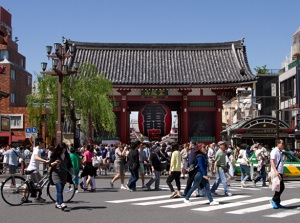
Sensoji temple in Asakusa, Tokyo
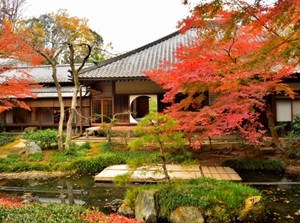
Meigetsuin temple in Kamakura
Kansai Region
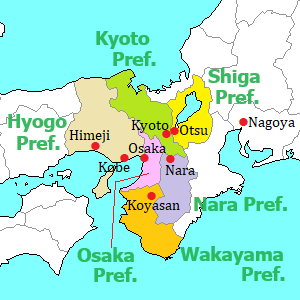
Osaka (大阪) is the central city in Western Japan.
The history is far older than Tokyo, and the city has a little different atmosphere from Tokyo.
Kansai International Airport is located about 40 km southwest of Osaka city, and it is another main entrance into Japan.
Kyoto (京都) is the most major historic city in Japan and is located about 40 km northeast of Osaka.
From 794 to 1868, it had been the capital of Japan for over 1,000 years.
The emperors had lived in Kyoto and the graceful culture had been created by the court nobles.
Nara (奈良) is the capital city before Kyoto.
It was in the center of Japan from 710 to 784, and there was the government based on Buddhism.
Koyasan (高野山) is well-known as a sacred town of Buddhism and was constructed in the 9th century.
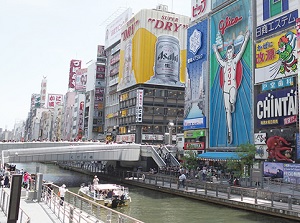
Dotonbori in Osaka

Kinkakuji temple in Kyoto
Northern Japan
Tohoku Region
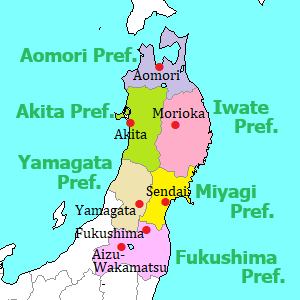
Tohoku Region is located to the north of Kanto Region, and is in the northeastern part of Honshu Island.
Tohoku Region is far from the Western Japan.
Therefore, the region had been out of the influence area of the government in Kyoto until the middle ages.
But the independent political powers were dotted in Tohoku, and strong families had governed the areas.
From the background, there are many local areas with unique traditional culture in the mountainous Tohoku Region.
The climate is a little cooler than the other regions in Honshu Island.
Especially, it is very cold in the northern half of Tohoku Region in winter and heavy snow falls on the side of the Sea of Japan.
The central city is Sendai (仙台) in the middle part of Tohoku Region.
There are six prefectures and each has a unique history and culture.
To the south of Sendai, there are Fukushima (福島) and Aizu-Wakamatsu (会津若松).
There is Yamagata (山形) just to the west of Sendai and Matsushima (松島) and Hiraizumi (平泉) are the popular spots just to the north of Sendai.
In the north part of Tohoku Region, there are Morioka (盛岡), Akita (秋田) and Aomori (青森) cities, and the cultural characteristics are unique.
Tohoku Shinkansen runs from south to north through the region and the branch lines lead to the other main cities in the region.
Therefore, the tourists can visit the region relatively easily from Tokyo.
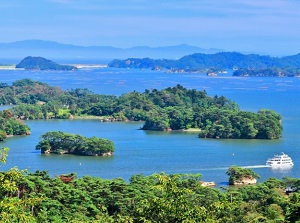
Matsushima in Miyagi Prefecture
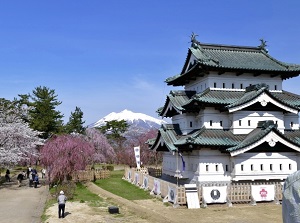
Hirosaki castle in Aomori Prefecture
Hokkaido Region
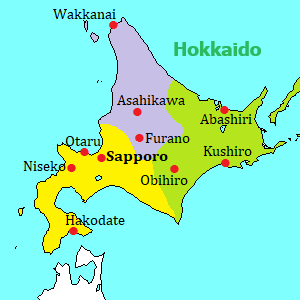
Hokkaido is a large island and is a region.
Ainu had lived in Hokkaido since ancient times, and they had traded with the people in Honshu Island from the middle ages.
From the late 19th century, Japanese government developed Hokkaido and it became a big region.
Therefore, there are few spots relating to Japanese traditional culture in Hokkaido.
It is cool in summer and it is very cold in winter.
The climate is similar to northern Europe.
Sapporo (札幌) is the central city in Hokkaido and half of Hokkaido's population is concentrated around Sapporo.
Hakodate (函館) is at the south end of Hokkaido and is the nearest city to Honshu Island.
In the center of Hokkaido Island, there are Asahikawa (旭川) and Furano (富良野).
In the eastern area, there are Obihoro (帯広), Kushiro (釧路) and Abashiri (網走).
On the north tip of Hokkaido, there is Wakkanai (稚内).
There is Sakhakin Island in Russia about 43 kilometers north of Wakkanai, so it is the nearest foreign country from Japan.
The population density is low, and we can see the vast wild fields which are not seen in the other regions in Japan.
And the wild nature is very wide.
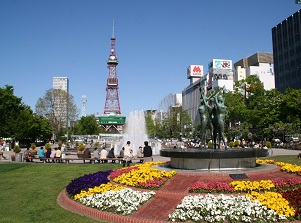
Odori Park in Sapporo city
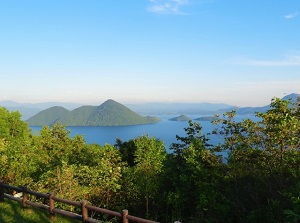
Lake Toya in southern Hokkaido
Central Japan
Koshin-etsu Region
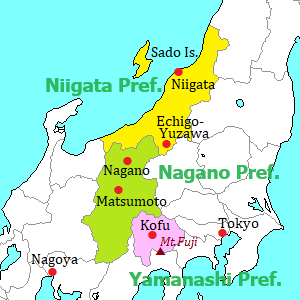
Koshin-etsu means three prefectures of Yamanashi, Nagano and Niigata.
The region is mainly mountainous area, and there are many popular high mountains and plateaus in the region.
The region located just on the western side of Kanto Region, and main railways and expressways are connected directly to Tokyo.
Yamanashi Prefecture is right next to Tokyo Prefecture and the east part is on the north side of Mount Fuji (富士山).
Nagano Prefecture is at the center of Honshu Island and the area is wide.
A few mountain ranges run from north to south, and there are many mountains over 2,500 to 3,000 meters.
These are called "Japan Alps", and are popular with alpinists.
Nagano (長野) and Matsumoto (松本) are the main cities.
Niigata Prefecture faces the Sea of Japan and tasty rice and sake are well-known.
Much snow falls in winter and some ski resorts are in the mountain.
Niigata (新潟) city is the largest city on the side of Sea of Japan.
Echigo-Yuzawa (越後湯沢) is popular with ski resort.
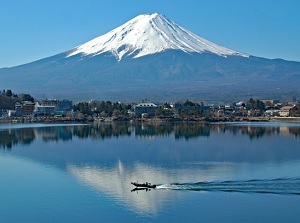
Lake Kawaguchi & Mt.Fuji in Yamanashi Prefecture
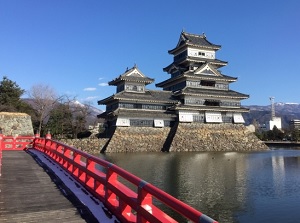
Matsumoto Castle in Nagano Prefecture
Hokuriku Region
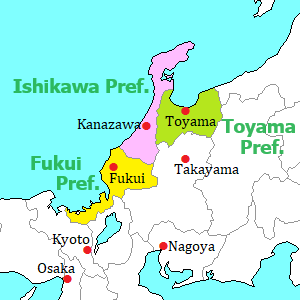
Hokuriku Region is located along the middle part of the coast on the side of the Sea of Japan.
There are three prefectures and they are Toyama, Ishikawa and Fukui.
The central city in Ishikawa Prefecture is Kanazawa (金沢), and the north part of the prefecture runs out to the north as Noto Peninsula (能登半島).
Kanazawa was the largest city in Edo Period (1603-1868), and the traditional culture from Kyoto developed.
In Toyama Prefecture, there are magnificent Mount Tateyama and steep Kurobe gorge, and Tateyama Kurobe Alpine Route is popular.
Fukui Prefecture is close to Kyoto and Osaka, so Obama (小浜) city developed in Edo Period as the entrance to Kyoto on the side of the Sea of Japan.
Hokuriku Shinkansen comes through Nagano from Tokyo directly.
And limited expresses run from Osaka, Kyoto and Nagoya frequently.
So it is easy to visit Hokuriku Region.

Old street in Kanazawa city
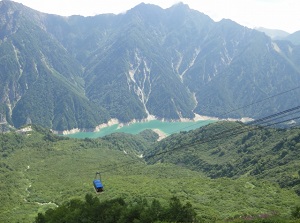
Kurobe Dam on Tateyama Kurobe Alpine Route
Tokai Region
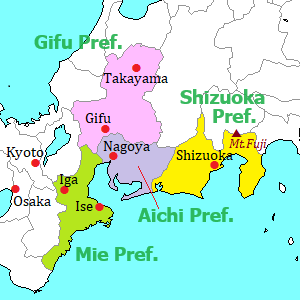
Tokai Region is the third largest economic area in Japan after Tokyo area and Osaka area.
It is located just between Kanto Region and Kansai Region, and the central city is Nagoya (名古屋) which is the fourth largest city in Japan.
It is in Aichi Prefecture, and the area produced some famous samurai warriors in the 16th century.
So some cities with castle are dotted in the area.
Gifu Prefecuture is to the north of Aichi Prefecture, and there are Takayama (高山) city and Shirakawa-go (白川郷) with unique traditional houses.
Mie Prefecture is to the south of Aichi Prefecture, and there are Ise Shrine (伊勢神宮) which is the center of all Shinto shrines in Japan and Iga (伊賀) city which produced "Ninja".
The eastern half of Tokai Region is Shizuoka Prefecture, and is the southern side of Mount Fuji (富士山).
On the eastern edge, there is Izu Peninsula (伊豆半島) and there are many hot spring resorts.
The route connecting Tokyo and Kyoto, Osaka has been the most important and the busiest in Japan.
It runs through this region and has been called "Tokaido".
The trains of Tokaido Shinkansen are operated at a maximum speed of 285 km/h every some minutes like commuter train.
So it is very convenient to visit Tokai Region.
And there is Chubu International Airport about 35 km south of Nagoya.
It is a good idea to enter Japan from the airport.
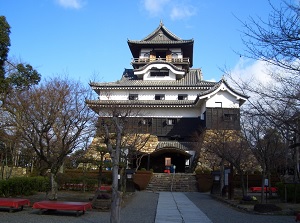
Inuyama Castle in Aichi Prefecture
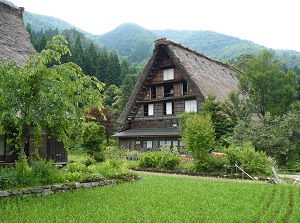
Shirakawa-go in Gifu Prefecture
Western Japan
Chugoku Region
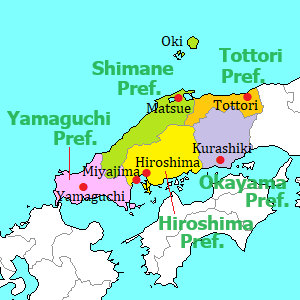
Chugoku Region is to the west of Kansai Region and is located in the western part of Honshu Island.
It is long from east to west.
The north side faces the Sea of Japan and there are Tottori and Shimane Prefectures.
The area is called San-in.
The south side faces Seto Inland Sea (Seto-Naikai in Japanese) and there are Okayama, Hiroshima, Yamaguchi Prefectures.
The area is called San-yô
Seto Inland Sea is between San-yô and Shikoku island and like a strait.
There are many islands in the sea.
The whole area in Chugoku Region is mountainous and the flat plains are narrow.
In San-in area, much snow falls in winter.
The largest city is Hiroshima, and there are the monuments and museum relating to atomic bomb.
Miyajima (Itsukushima Shrine) is popular spot near Hiroshima.
There are attractive small towns in Chugoku region.
In San-yo area, Kurashiki and Onomichi are popular.
In San-in area, Matsue, Hagi, Tsuwano and Yamaguchi have old towns.
San-yo Shinkansen runs along Seto Inland Sea.
From Okayama, limited expresses runs to San-in area.
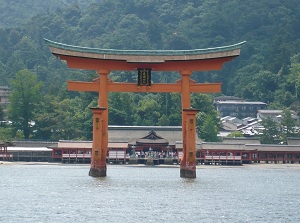
Itsukushima Shrine in Hiroshima Prefecture
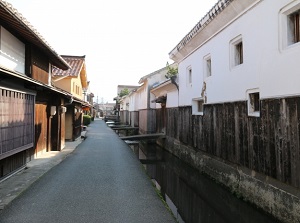
Old town of Kurayoshi city in Tottori Prefecture
Shikoku Region

Shikoku Island is a region, and is located to the south of Chugoku Region.
The northern coast faces Seto Inland Sea and the southern coast faces wide Tosa Bay connecting to the Pacific Ocean.
Whole area is mountainous and relatively steep.
Takamatsu in Kagawa Prefecture, Tokushima in Tokushima Prefecture, Matsuyama in Ehime Prefecture and Kochi in Kochi Prefecture are the central cities in each prefecture.
These cities have been the center of each area since the middle ages.
The castles were constructed in some cities including above cities and four castles of them are original.
There are many Buddhist temples in Shikoku.
88 temples of them are associated with high priest Kuukai in the 9th century, and the route visiting the temples is well-known as a pilgrimage route.
The pilgrims walking on the road are seen in Shikoku throughout the year.
The train of limited expresses run from Okayama into Shikoku.
The express buses run from Kobe through Awaji Island into Shikoku.
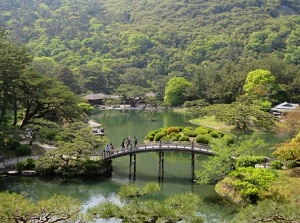
Ritsurin Park in Takamatsu city
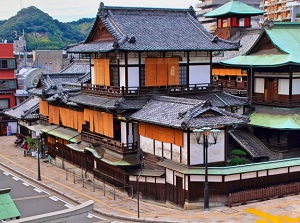
Old public bathhouse of Dogo-onsen
in Matsuyama city
Kyushu Region
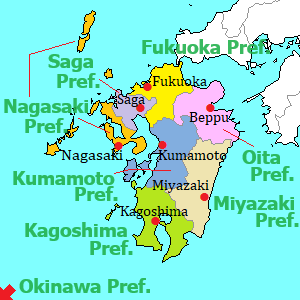
Kyushu Island is also a region, and is located to the southwest of Chugoku Region and Shikoku Region.
Very narrow Kanmon Straits is between the western end of Honshu Island and the northern tip of Kyushu Island, and a few bridges and undersea tunnels connect both islands.
Kyushu Island has also a lot of mountains.
Especially, a volcanic belt runs through the island from north to south and there are some active volcanoes on the belt.
Mount Aso, Mount Unzen, Mount Kirishima and Sakurajima are very active.
And there are popular hot spring resorts of Beppu, Yufuin, etc. at the north end of the volcanic belt.
The norteastern coast faces Seto Inland Sea, the southeastern coast faces the Pacific Ocean, the northwestern coast faces the Sea of Japan, and the southwestern coast faces East China Sea.
The eastern coast of Kyushu is indented and there are many bays and islands.
The central city in Kyushu is Fukuoka.
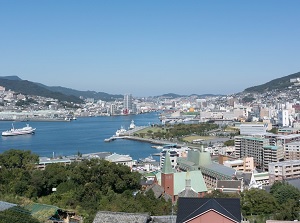
Nagasaki port and Nagasaki city
There are Saga and Nagasaki to the west of Fukuoka.
Nagasaki was the second city that atomic bomb was dropped after Hiroshima in 1945.
There are Kumamoto and Kagoshima on the west side and Oita and Miyazaki on the east side.
In the ancient times, Kyushu was a remote region from Kyoto and Edo (Tokyo).
But it was the place that Japan had a relationship with China and Korea.
In the 13th century, the Mongol Invasions attempted against Japan in Kyushu.
In the 16th century, Europeans introduced guns and the Christian religion in Kyushu.
Therefore, each area in Kyushu has a unique history and culture.
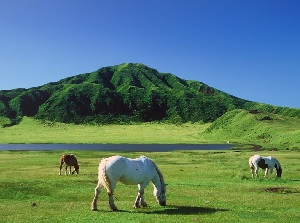
Mount Aso in Kumamoto Prefecture

Nagasaki port and Nagasaki city
Islands to the south of Kyushu island
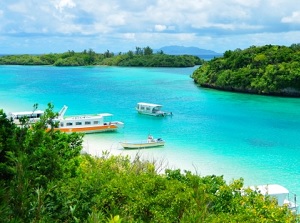
Kabira Bay in Ishigaki Island
Small islands are dotted on a line from the south of Kyushu Island to Taiwan.
Yakushima is a popular island located just to the south of Kyushu Island.
There is Okinawa island in the middle part.
Okinawa was a kingdom from 1429 to 1879.
So it has a different culture from the mainland of Japan.
Miyako Island, Ishigaki Island, Taketomi Island and Iriomote Island are popular.
Selected places in Japan
In "The New York Times" and "National Geographic", the following places have been introduced.
Tokyo, Kyoto, Osaka, Hokkaido had been selected.
They have been very popular and many foreign tourists visit there.
Recently, local cities and places are selected and the people in the places were surprised.
2019 : The islands in Seto Inland Sea
The followings are the islands.
2023 : Morioka, Fukuoka
2024 : Yamaguchi
2025 : Toyama, Kanazawa

